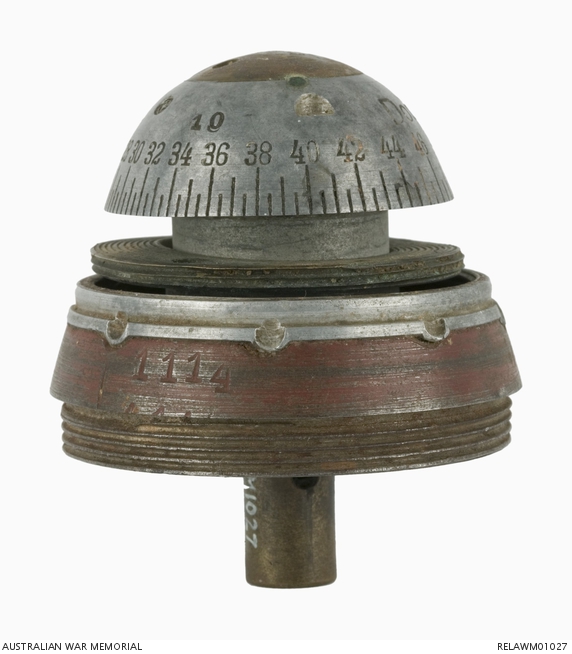| Place | Middle East: Ottoman Empire, Turkey, Dardanelles, Gallipoli |
|---|---|
| Accession Number | RELAWM01027 |
| Collection type | Technology |
| Object type | Munition |
| Physical description | Metal |
| Location | Main Bld: First World War Gallery: The Anzac Story: Gallipoli: Life at Anzac 1 |
| Maker |
Unknown |
| Place made | Germany |
| Date made | c 1914-1915 |
| Conflict |
First World War, 1914-1918 |
Turkish shell fuze : Major T H Darley, 9 Light Horse Regiment, AIF




Fired metal nose fuze from a German made artillery shell. Around the edge of the nose fuze cap is impressed a scale from 20 to 48 (200 to 4800 metres). These lines are used to indicate at what range the shell was to explode. '96 n/A' indicates that is it from a model 1896 Neu Art artillery piece. The number 1114 has been impressed into the lowest part of the fuze.
This fuze from a German made Turkish shell struck and damaged the sun helmet (see RELAWM01026) worn at Gallipoli by Major Thomas Henry Darley, 9 Light Horse Regiment, AIF. He provided the following story about the incident; 'On the 12th June 1915 I had been working for a couple of hours in a certain spot at Anzac, and moved about 3 yards away to speak to Major Alfred Edward Cook (also 9 LHR). Just at that moment 'Anafacta Liz'(?) started and the first shell landed over the spot I had been working in, killing one and wounding the other of my assistants. The pellets flew round Major Cook and I, one hitting him in the left breast but I remained unhurt - although my sleeve was ripped by them. The fuze of the shrapnel shell, which burst about 10 feet overhead, behind me, went clean through my helmet, without touching my head, but the helmet flew about 30 yards. The shell killed two, 4 wounded (Major Cook died or wounds on 4 July 1915), 3 mules killed.'. A few days later Major Darley was blown about twelve feet by a shell that fell at his feet but once again he was unhurt although the rest of his party were killed.